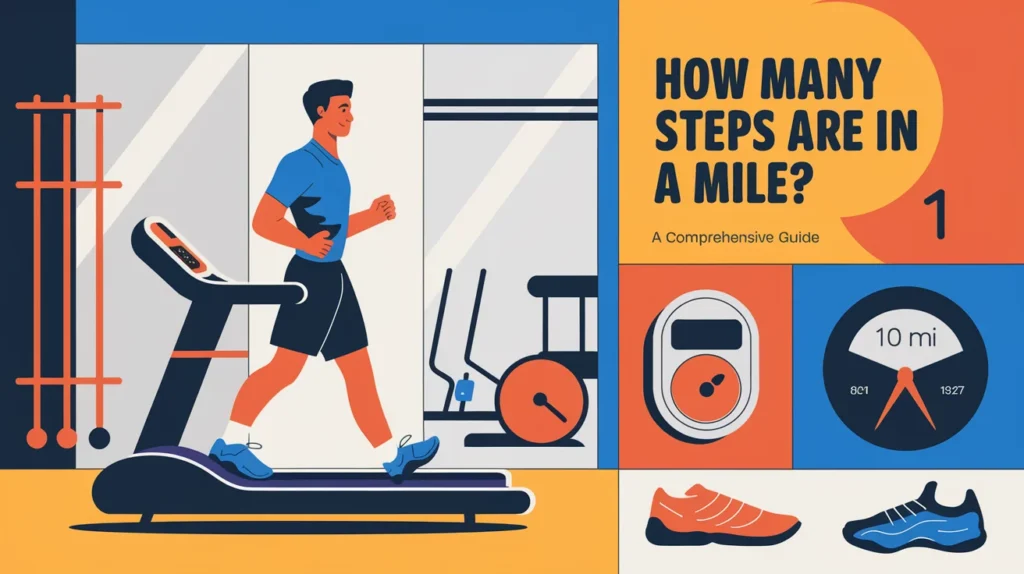Understanding the number of steps in a mile is crucial for anyone tracking their physical activity, aiming for fitness goals, or simply curious about their walking or running habits. The steps-per-mile count isn’t a fixed number; it varies based on factors like stride length, pace, height, and individual biomechanics. This comprehensive guide delves into these variables, provides methods to calculate your personalized steps-per-mile, and offers insights to enhance the accuracy of your fitness tracking.
Factors Influencing Steps Per Mile
Several elements determine the number of steps you take to cover a mile:
- Pace and Speed: Walking at a leisurely pace results in more steps per mile compared to brisk walking or running, due to shorter strides.
- Stride Length: This is the distance covered between two consecutive footfalls. A longer stride means fewer steps per mile.
- Height and Leg Length: Taller individuals typically have longer legs, leading to longer strides and fewer steps per mile.
- Terrain and Surface: Uneven or uphill terrains can shorten stride length, increasing the number of steps.Verywell Fit
- Footwear and Physical Condition: Comfortable shoes and good physical health can promote a natural stride, affecting step count.
Average Steps Per Mile by Pace

The number of steps per mile varies with the pace of movement. Here’s an approximate breakdown:
| Pace | Speed (mph) | Average Steps per Mile |
| Slow Walk | 2.0 | 2,640 |
| Moderate Walk | 3.0 | 2,200 |
| Brisk Walk | 4.0 | 1,800 |
| Jog | 5.0 | 1,600 |
| Run | 6.0 | 1,400 |
| Fast Run | 7.5 | 1,200 |
These figures are averages and can vary based on individual stride length and biomechanics.
Steps Per Mile Based on Height: A Detailed Scientific Guide
Understanding how many steps you take per mile is crucial for fitness tracking, weight management, and setting realistic health goals. Since stride length varies significantly with height, taller individuals cover more ground with fewer steps, while shorter people require more steps to complete the same distance.
This in-depth guide explores:
✅ How height affects step count (with scientific explanations)
✅ Precise steps-per-mile calculations (for walking & running)
✅ Custom stride length measurement methods
✅ Fitness tracker accuracy tips
✅ Optimizing step counts for weight loss & cardio health
How Height Directly Impacts Steps Per Mile
1. The Science Behind Stride Length & Height
Stride length (distance between two consecutive steps) is proportional to leg length, which correlates strongly with overall height.
- Average Walking Stride Length ≈ 2.2 to 2.5 ft (for most adults)
- Average Running Stride Length ≈ 2.5 to 3.3 ft (longer due to momentum)
Formula:
Steps per mile=5,280 ft (1 mile)Stride length (ft)
Steps per mile=
Stride length (ft)
5,280 ft (1 mile)
2. Gender Differences in Stride Length
Studies show that at the same height:
- Men typically have 5-10% longer strides due to wider hip structure.
- Women take slightly more steps per mile.
Comprehensive Steps-Per-Mile Chart (Walking & Running)
| Height (ft/in) | Avg. Walking Stride (ft) | Steps/Mile (Walk) | Avg. Running Stride (ft) | Steps/Mile (Run) |
| 4’10” – 5’1” | 2.0 – 2.2 | 2,600 – 2,800 | 2.4 – 2.6 | 2,000 – 2,200 |
| 5’2” – 5’5” | 2.2 – 2.4 | 2,400 – 2,600 | 2.6 – 2.8 | 1,900 – 2,100 |
| 5’6” – 5’9” | 2.4 – 2.6 | 2,200 – 2,400 | 2.8 – 3.0 | 1,700 – 1,900 |
| 5’10” – 6’1” | 2.6 – 2.8 | 2,000 – 2,200 | 3.0 – 3.2 | 1,500 – 1,700 |
| 6’2” – 6’5” | 2.8 – 3.0 | 1,800 – 2,000 | 3.2 – 3.5 | 1,300 – 1,500 |
| 6’6”+ | 3.0 – 3.3 | 1,600 – 1,800 | 3.5 – 4.0 | 1,100 – 1,300 |
Note: Values are estimates. For exact numbers, measure your personal stride length.
How to Measure Your Exact Stride Length
Method 1: The 20-Step Test (Most Accurate)
- Mark a starting point.
- Walk 20 natural steps (don’t force longer strides).
- Measure the total distance covered in feet.
- Divide by 20 to get average stride length.
Example:
- Distance covered = 52 ft
- Stride length = 52 ÷ 20 = 2.6 ft
- Steps per mile = 5,280 ÷ 2.6 ≈ 2,031 steps
Method 2: Height-Based Estimation
For a quick estimate:
- Walking Stride ≈ Height (ft) × 0.413
- Running Stride ≈ Height (ft) × 0.45
Example (5’8” person):
- Height = 5.67 ft
- Walking stride = 5.67 × 0.413 ≈ 2.34 ft
- Steps per mile = 5,280 ÷ 2.34 ≈ 2,256 steps
Why Step Count Accuracy Matters
- Fitness Goals: A 6’4″ person walking 10,000 steps covers ~5 miles, while a 5’2″ person covers ~4 miles.
- Calorie Burn: More steps = higher energy expenditure.
- Health Tracking: Doctors recommend 7,000–10,000 steps/day for heart health.
How to Improve Fitness Tracker Accuracy
- Manually input stride length in your device settings.
- Calibrate GPS (for outdoor tracking).
- Wear tracker on the wrist (not pocket) for better motion detection.
✔ Taller people take fewer steps per mile (longer strides).
✔ Measure your stride length for precise step counting.
✔ Adjust fitness tracker settings to avoid undercounting.
✔ 10,000 steps ≈ 4–5 miles, depending on height.
Pro Tip: If weight loss is your goal, combine step tracking with inclined walking or interval training for better results!
How to Calculate Your Personal Steps Per Mile Accurately
Why Your Steps Per Mile Matter
Generic step counts (like 2,000 steps = 1 mile) don’t account for height, leg length, or walking style. Calculating your personal steps per mile ensures:
✔ Accurate fitness tracking
✔ Better goal setting (weight loss, running targets)
✔ Improved pedometer/smartwatch data
3 Simple Steps to Find Your Steps Per Mile
Step 1: Measure Your Stride Length
(Distance from one heel strike to the next of the same foot)
Option A: Manual Measurement (Most Accurate)
- Walk 10 natural steps on a flat surface.
- Measure the total distance (in feet).
- Divide by 10 → Your stride length.
Example:
- 26 feet / 10 steps = 2.6 feet per stride.
Option B: Quick Height-Based Estimate
- Men: Height (inches) × 0.415 = Stride (feet)
- Women: Height (inches) × 0.413 = Stride (feet)
(Note: Less precise than manual measurement.)
Step 2: Calculate Steps Per Mile
1 mile = 5,280 feet
Formula:
Your Steps Per Mile=5,280Your Stride Length (feet)
Your Steps Per Mile=
Your Stride Length (feet)
5,280
Example:
- Stride = 2.5 ft → 5,280 / 2.5 = 2,112 steps/mile
(Pro Tip: Use a calculator for quick results!)
Step 3: Verify with a Fitness Tracker
- Walk a measured distance (e.g., ¼-mile track).
- Compare your tracker’s step count vs. manual calculation.
- Adjust stride length in your device settings if needed.
Average Steps Per Mile (By Height)
| Height Range | Approx. Stride Length | Steps Per Mile |
| 5’0” – 5’4” | 2.1 – 2.3 ft | 2,300 – 2,500 |
| 5’5” – 5’9” | 2.3 – 2.5 ft | 2,100 – 2,300 |
| 5’10”+ | 2.5 – 2.7 ft | 1,900 – 2,100 |
Remember: These are estimates—calculate yours for precision!
Pro Tips for Accuracy
- 🚶 Walk naturally—don’t force longer strides.
- 🔄 Recheck yearly (stride can change with age/fitness).
- 📱 Sync devices (update stride length in Fitbit, Apple Health, etc.).
Ditch generic estimates! Spend 5 minutes measuring your stride to unlock personalized, accurate fitness data. Whether you’re counting steps for health, weight loss, or training, this method ensures reliable tracking.
Tools and Devices for Tracking Steps
Modern technology offers various tools to track steps and distance:
- Pedometers: Simple devices that count steps based on motion detection.
- Fitness Trackers: Wearable devices like Fitbit, Garmin, and Apple Watch that monitor steps, distance, heart rate, and more.
- Smartphone Apps: Applications such as Google Fit and Apple Health use built-in sensors to track movement and estimate steps.
Tip: Regular calibration of these devices ensures accuracy, as factors like device placement and individual gait can affect readings.
Benefits of Tracking Steps
Monitoring your step count offers several health and fitness advantages:
- Motivation: Setting and achieving step goals can motivate increased physical activity.Verywell Health+1Verywell Health+1
- Health Insights: Regular tracking can highlight activity patterns and areas for improvement.
- Goal Setting: Helps in setting realistic fitness goals and monitoring progress.
- Calorie Tracking: Assists in estimating calories burned based on steps taken.
Conclusion
Understanding the factors that influence the number of steps in a mile can enhance your fitness tracking and goal setting. By considering elements like pace, height, and stride length, and utilizing modern tracking tools, you can gain a clearer picture of your physical activity and work towards achieving your health objectives.
FAQs
Q: How many steps are in a mile for an average adult?
A: On average, an adult takes about 2,000 to 2,500 steps to walk a mile, depending on stride length and pace.Verywell Fit+1Verywell Health+1
Q: Does running a mile take fewer steps than walking?
A: Yes, running typically involves longer strides, resulting in fewer steps per mile compared to walking.
Q: How can I increase my steps per mile?
A: To increase steps per mile, focus on shortening your stride and increasing step frequency. However, ensure this doesn’t compromise comfort or lead to injury.
Q: Are fitness trackers accurate in counting steps?
A: Fitness trackers provide a good estimate but may have slight inaccuracies. Regular calibration and proper placement can improve accuracy.
Q: How does terrain affect steps per mile?
A: Uneven or uphill terrains can shorten stride length, leading to an increased number of steps per mile.
Q Does walking speed affect steps per mile?
✅ Yes! Faster walking increases stride length, reducing steps per mile.
Q How many steps should I aim for daily?
- Sedentary: 5,000–7,000 steps
- Active: 7,000–10,000 steps
- Weight Loss: 10,000–12,000+ steps
Q Are smartwatches or pedometers better for counting steps?
- Smartwatches (Apple Watch, Garmin) → More accurate (95%+).
- Pedometers → Cheaper but less precise (~85% accuracy).


